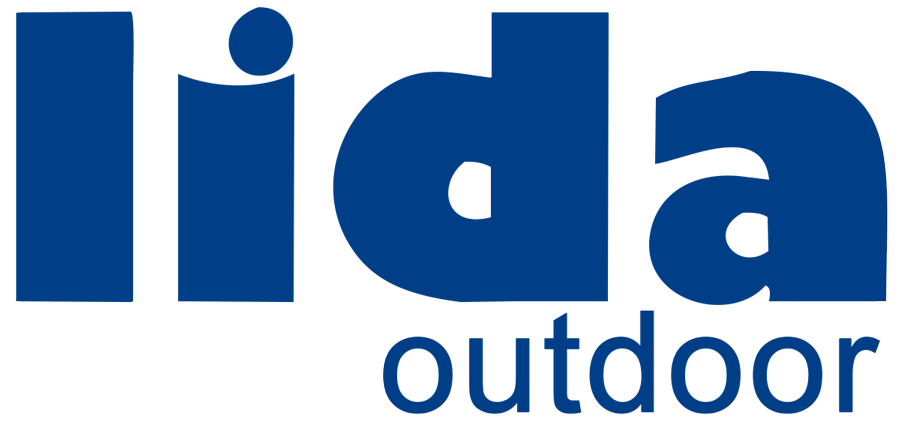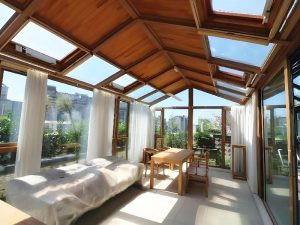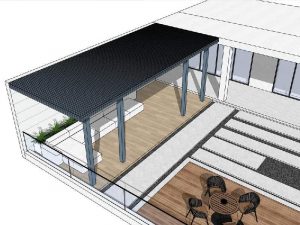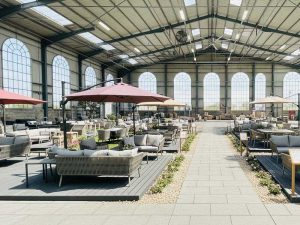Gazebos have always been a hit in the U.S. and Europe—for shade, for style, and for creating inviting outdoor spaces. Over the past two decades, as China’s manufacturing capabilities and design quality improved, more buyers started sourcing gazebos directly from Chinese factories. Why? More design options, better pricing, and faster delivery—it’s hard to ignore. But let’s be honest. The process isn’t always smooth.
Will the product quality stay consistent? Can the factory deliver the same quality in mass production as they did in samples? Is the supplier actually reliable? These questions can make or break your business once the goods land in your warehouse. So here’s the big question: What really matters when sourcing gazebos from China?
That’s exactly what this article will cover. Whether you’re placing your first bulk order or expanding your supplier list, you’ll find clear, practical advice to help you navigate the sourcing process.
💡Important Note for U.S. Buyers:
As of April 2025, the U.S. is imposing up to 145% import duties on certain gazebo products from China. If your target market is the U.S., make sure to read Section 5: Tariffs & Compliance Risks closely.
1. Know What You Need: The #1 Mistake First-Time Buyers Make
If this is your first time sourcing gazebos from China, here’s a common pitfall—asking for quotes before you know what you want. From a Chinese supplier’s perspective, vague inquiries without clear specs often go to the bottom of the pile—or worse, get ignored altogether.

Before you hit “Send Inquiry,” take a moment to figure out the following:
- What style of gazebo do you want?
- What size and structure are you looking for?
- What color and exterior finish do you prefer?
- What material do you want for the roof?
- How many units do you plan to order?
Pro Tip: If you want Chinese factories or trading companies to take you seriously, your first email matters. Make sure it clearly states:
- Who are you (Brand, wholesaler, project buyer)?
- What type of gazebo you want, including size, structure, color, and quantity
- When do you plan to order and where it should be delivered
- Whether you need custom logos, packaging, or other services
Even if you’re starting with a small trial order, professional communication helps you stand out—and the right factory will treat you as a serious customer.
2. Know Who You’re Dealing With: Factory vs. Trading Company
If you’re new to buying gazebos from China, you might not know whether you’re talking to a factory or a trading company. And that matters—a lot. In China, many companies on sourcing platforms look professional, but they don’t actually manufacture anything. Instead, they act as middlemen. They combine products from different factories and focus on pricing and packaging deals.
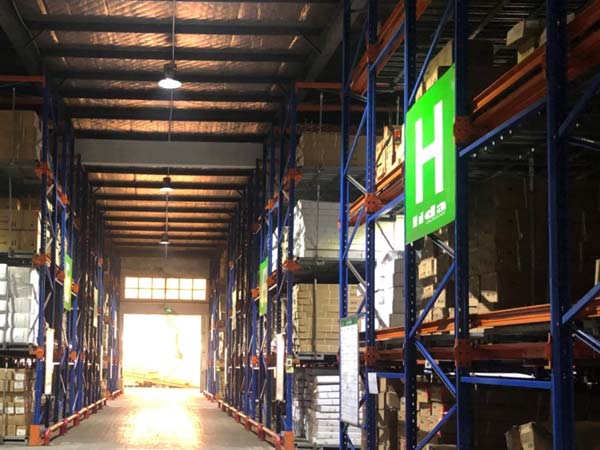
While this works for experienced buyers, it can be risky for first-timers. If you need consistent quality or want custom features, choosing the wrong type of supplier can derail your entire project.
Factory vs. Trading Company: Which One Fits You?
| Category | Factory (Manufacturer) | Trading Company |
| Own Production Line | Yes – Direct control over quality and schedule | No – Relies on partner factories |
| Customization | Flexible with colors, structure, logo, and packaging | Limited – Mostly standard ready-made options |
| Communication | Direct and fast – Strong technical understanding | Slower – Info goes through layers |
| Unit Cost | Lower (no middleman markup) | Higher – Includes markup |
| Export Handling | Many can handle customs clearance themselves | Often better at handling paperwork and export |
| Best For | Long-term, high-volume, customized projects | Small orders, product mix, quick trials |
Sourcing Tip
If your focus is long-term cooperation, product customization, and cost control—go straight to a factory. You’ll get better consistency, better pricing, and more control over delivery time. But if you’re testing the market with a small trial order, or want to buy different product types in one go, a reliable trading company can save you a lot of coordination work.
Whichever you choose, make sure they’re transparent and cooperative. Don’t rely on the catalog alone—ask for a factory video tour, compare sample consistency, verify business licenses, or even arrange third-party inspections.
3. Samples and Spec Confirmation
Your First Line of Defense Against Costly Mistakes
Whether you’re ordering 50 gazebos or 5,000, the sample is the foundation of your entire deal. If you skip it—or treat it like a formality—you’re setting yourself up for trouble. Size mismatches, off-color parts, poor joints, unstable frames… these things often don’t show up until the mass production is done and the goods are already on a ship. And by then, it’s too late.
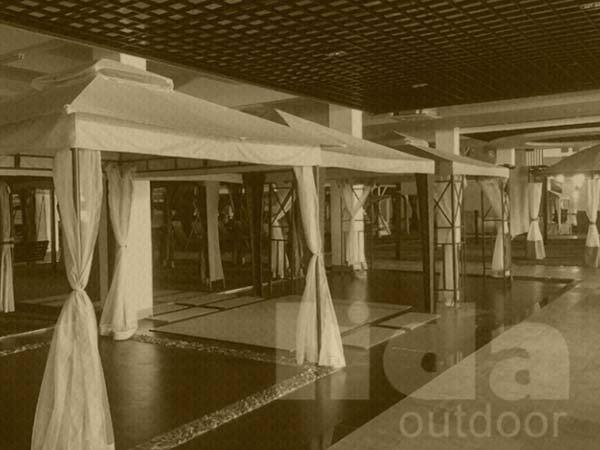
A common rookie mistake? Thinking the sample stage isn’t necessary. But for something as complex as a gazebo—with frames, fabric, fittings, and dozens of components—your sample is your only real control over quality and detail. Don’t take it lightly. And there are 5 key things to confirm during sampling:
1) Size and Structure
- Are the assembled dimensions accurate and matching the drawings?
- Is it easy to set up and take down? Any loose or mismatched parts?
- Are details like base plates, roof supports, and drainage holes complete?
2) Frame and Canopy Materials
- Is the frame made from the agreed material (e.g., aluminum or galvanized steel)? Is thickness specified?
- Is the canopy polyester or oxford? Does it have a waterproof coating? Any wrinkling or fraying?
3) Surface Finish and Color
- Is the coating smooth and consistent? Any peeling or color difference?
- Are special finishes like wood grain, matte black, or antique bronze done correctly?
- Does fabric or polycarbonate color match the sample photo or swatch?
4) Packaging
- Is there a clear assembly manual (at least in English)?
- Are accessories separately packed? Are the hardware kits complete? Are foam pads and corner protectors included?
- Is the outer box strong enough? Is your logo printed? Does it meet export or retail packaging standards?
5. Logo and Custom Details
- Do printed logos, tags, manuals, QR codes, etc., match your design files?
- If you’re selling on Amazon, e-commerce platforms, or to supermarkets—does it meet barcode and packaging specs?
Pro Tips:
- Ask the supplier for detailed photos, videos, and packaging images during sampling.
- If budget allows, request physical samples—especially for roof fabric, frame sections, and connectors.
- If you can’t receive samples, arrange a video call or live demo and review each detail together.
- Keep a record of all confirmations (email threads or chat screenshots). These are crucial when you check the bulk order later.
4. MOQ and Custom Orders
Why Factories Don’t Love Small Orders (and What You Can Do About It)
Here’s a question many new buyers ask: “Why can’t I just order 30 units to test it out?” Or, “Why did the price change when I asked about the MOQ?” Don’t worry—it’s not that the factory is being difficult. The issue is built into how manufacturing works, especially for something like a gazebo.

Gazebos are made of multiple parts and materials. Setting them up for production requires upfront costs, such as buying raw materials, prepping molds, scheduling workers, etc. Whether you order 10 sets or 100, these setup costs stay almost the same. So when the order is small, the cost per unit goes up.
What Is MOQ, Really?
MOQ stands for Minimum Order Quantity. And it’s not random—it’s based on real limitations like:
- Bulk material purchases—Fabrics, aluminum, and powder coating must often be bought by the roll or batch. A small order won’t use everything.
- Production efficiency – Small batches may not justify a full production line, leading to slower, more costly hand processing.
- Packaging and branding costs – Custom cartons or printed logos also have their own MOQ.
- Shipping & container loading – Full container loads are cheaper per unit. Small orders may require shared containers, which complicates logistics.
For most factories, the MOQ ranges from 50 to 200 sets, depending on product complexity, materials, and whether customizations are needed.
So, How Can You Work Around MOQ?
1) Sample + Trial Order Combo
Factories do accept small orders—if they see long-term potential. You can offer to pay for a sample (which often gets deducted later) and propose a “30-set trial now, 100+ sets later” plan. Don’t just say “I want to test it.” Instead, show a step-by-step plan. That makes a big difference.
2) Choose Standard Models to Lower MOQ
Custom products usually require a higher MOQ. But if you’re okay with the factory’s existing size and color options, they may lower the minimum. Even better—if it’s off-season stock or leftover from a big project, MOQ can go as low as 10–20 units.
3) Plan Ahead—Don’t Rush the Factory
Outdoor furniture factories get slammed between March and July. If you ask for fast delivery and low MOQ at the same time, it’s a tough ask. Give them time to slot your order in, and they’ll be more flexible.
5. Tariffs & Compliance Risks
Don’t Let Hidden Costs Kill Your Profit
You’ve found a good factory. The price looks great. The quality seems solid. So the hard part’s done—right? Not quite. There’s one more invisible wall between you and successful sales in the U.S. or Europe: Import duties and compliance requirements. If you ignore these, your products might get stuck at customs, hit with massive taxes, or even rejected or destroyed. You could lose not just money—but time you’ll never get back.
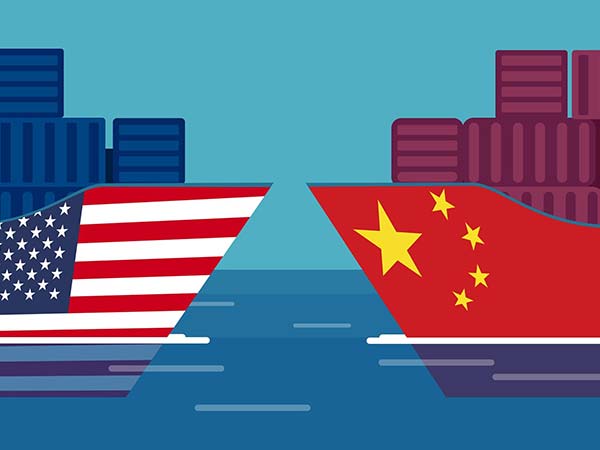
Import Duties for Gazebos Vary by Country
1) Europe: Most European countries have moderate import tariffs for gazebos, usually 2% to 8%. But don’t forget the VAT (Value Added Tax), which can range from 15% to 25%. Make sure to confirm the correct HS Code (e.g., 9406 or 7308), as that determines your duty rate. Classification rules can vary slightly by country, so ask your factory or freight forwarder for guidance.
2) Middle East / Canada / Australia: These regions often have low or even zero tariffs on gazebos. However, they do require specific labeling and documents:
- Canada needs fire-safety labeling on fabric gazebos
- Australia emphasizes correct UV protection labels
- Most require proper COO (Certificate of Origin) and safety documentation
Always check the local import checklist, and confirm your supplier can provide the needed paperwork.
3) United States (High-Risk Zone): Starting in April 2025, the U.S. will impose a whopping 145% import tariff on gazebos made in China. So a product that costs $100 FOB could face $145 in tax, doubling your cost. If your market is the U.S., don’t wait until it’s too late. Start planning:
- Should you ship through a third country?
- Assemble components elsewhere?
- Or shift sourcing altogether?
Whatever you decide, do the math first—before the duties crush your margins.
Compliance: A Must for Online or Retail Sales
If you’re selling on Amazon, e-commerce platforms, or retail chains, compliance is non-negotiable. Here’s what you may need:
- Structural safety test reports (wind, weight, waterproof ratings)
- Environmental certifications (REACH, RoHS, Prop65)
Flame-retardant labeling (required in the EU, Canada, and several U.S. states) - Retail-ready packaging (with EAN/UPC barcodes, shipping labels)
- Multi-language manuals (English required; German, French often requested in the EU)
Not sure what’s needed?
- Ask your local import agent or Amazon compliance checker
- Ask your Chinese supplier to provide certification or third-party test reports
Special Note for U.S. Buyers
The China–U.S. trade war continues. And as of 2025, gazebos are on the U.S. high-tariff list. Here’s what it means:
- Even a cheap FOB price won’t save you—import costs skyrocket
- Many buyers are shifting sourcing to Southeast Asia or Mexico
- Others are shipping gazebo parts separately and assembling overseas to avoid “country-of-origin” tariffs
But be careful—gray-area tactics carry compliance and trademark risks. A better approach? Plan your supply chain with compliance in mind: For example, source metal parts in China, then package and ship from a third country. That way, you build a long-term strategy—not just a quick workaround.
6. Pricing Breakdown & Hidden Charges
Don’t Let “Cheap Quotes” Fool You
You might come across a factory offering super low prices for gazebos. But once you start ordering samples, customizing logos, or getting ready to ship—the “extras” start piling up: Logo fees, packaging upgrades, container reinforcement, even hardware kits charged separately. By the time everything’s added, the final cost is way higher than expected. To avoid surprises and get a realistic quote, you need to understand what makes up the total cost.
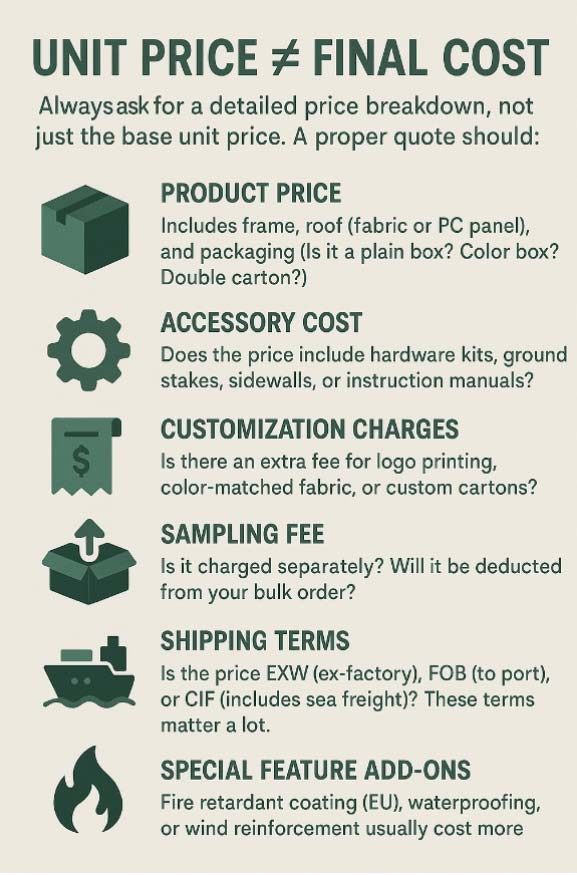
Pro Tips: How to Get a Transparent Quote
- In your first inquiry, clearly list all your needs: custom logo, packaging, sample request, delivery terms, etc.
- Ask for a detailed quotation sheet with product photos, specs, materials, lead time, and MOQ.
- Confirm if the quote includes FOB charges, container loading fees, palletizing, and more.
- Ask for a total cost summary: Example: Total = Unit Price × Quantity + Customization + Packaging + Other Fees
This helps you budget accurately and compare suppliers fairly.
7. Lead Times & Production Scheduling
Avoid the “Surprise Delays” During Peak Season
Many first-time gazebo buyers assume, “30 days should be enough for delivery, right?” Not always. That 30-day timeline is best-case. In reality, if you order during peak season, or request custom packaging, or the factory’s already overloaded, the lead time can stretch to 45, 60, or even 75 days.
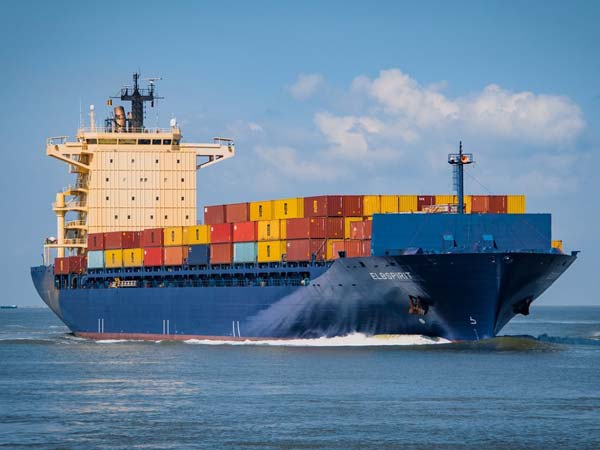
From March to July, outdoor furniture factories in China enter full-blown production season. Sample requests pile up, production lines are fully booked, and shipments are packed day and night. If you don’t secure your slot early, you could easily fall one or two weeks behind your expected timeline.
Pro Tips: How to Stay on Schedule
- Place your order at least 45–60 days in advance, especially from March to June. The earlier you confirm, the higher your priority in the production queue.
- Move fast during sampling. Confirm all details in one go to avoid back-and-forth and wasted time.
- Go with standard models if the timing is critical. Fewer custom elements = faster scheduling.
- Ask for a tentative production schedule from the factory. Know where your order sits in the queue.
- If your delivery timeline is non-negotiable, put it in the contract.Add delay penalty clauses if needed—this keeps everyone accountable.
8. Payment Terms & Contract Details
Protect Your Money—and Your Order
Many first-time gazebo buyers run into this: The factory asks for a “30% deposit, 70% before shipment.” You worry it’s a scam—but also don’t want to lose the deal. Truth is, deposits are common in international trade. What matters is whether you put the terms in writing—not just trust verbal promises.
Once you’re ready to place a formal order—regardless of the size—sign a contract, confirm payment terms in writing, and keep a full communication record. That’s the most direct way to protect yourself.
How to Make Payments with Confidence
- For first-time deals, consider platform-secured payments or split payments to reduce risk.
- Before payment, ask for the company registration info and bank account name, and check that they match.
- Save all communication records (quotes, sample confirmations, drawings) via email or chat.
- For larger orders, use a bilingual contract and invoice for added clarity.
- Before final payment, ask the factory to send photos or videos showing quantity and packaging.
- Only pay the final balance once you’ve confirmed everything is correct.
Common Payment Methods
| Payment Method | Best For | Pros | Notes |
| T/T (Wire Transfer) | Most standard orders | Simple process, widely accepted | 30% deposit + 70% before shipment is the norm |
| L/C (Letter of Credit) | Large orders, government projects | Bank-backed, secure | Complex, costly—usually not used for small orders |
| PayPal / Wise / Western Union | Samples or small test orders | Fast, easy to use | High fees, not ideal for large sums; not all factories support it |
What Should a Contract Include?
- Gazebo Product details: Model, color, size, material, quantity, unit price, total price—the more detailed, the better
- Delivery timeline: Clearly define when the lead time starts (e.g., after the deposit is received)
- Payment terms: When to pay, and how the balance will be handled
- Inspection: Whether third-party quality checks are allowed, and who pays for them
- Packaging: Custom packaging, palletizing, container loading requirements
- Delays & disputes: What happens if delivery is late or products don’t match the specs
- Legal terms: Most contracts default to Chinese law, but for larger deals, consider third-party arbitration (e.g., Hong Kong or Singapore)
9. Pre-Shipment Inspection & Checklist
Don’t Let a Small Slip-Up Cost You Big Time
A batch of gazebos has many parts, packaging steps, and assembly processes. One mistake can affect end use or cause the whole container to be delayed or returned. Inspection and container checks are a must, especially for first-time or custom orders.
5 Key Steps Before Shipment:
1) Product Consistency Check
Verify that the mass-produced items match the approved sample and check dimensions, structure, color, finish, and accessory contents.
2) Packaging Integrity Check
Ensure the agreed-upon outer boxes, color cartons, labels, and manuals are used. Confirm that packaging protects against pressure, moisture, and damage. Check that printed details like barcodes and logos are accurate.
3) Pre-Shipment Photos or Video
Ask the factory to record the finished products, packing orders, and container loading, and include clear shots of the container seal number for customs and receiving checks.
4) Third-Party Inspection (If Needed)
Consider hiring agencies like SGS, Intertek, or QIMA for AQL sampling. This helps confirm the product’s structure, function, and quantity. Typically, the buyer covers the cost. If needed, negotiate sharing the fees.
5) Document Checklist
Confirm the final packing list, commercial invoice, and certificate of origin (COO). Ensure all documents required for customs clearance are complete.
Final Thoughts
From defining your product needs to choosing the right supplier, from sample approval to managing lead times, payments, inspections, and customs—every step matters. It’s what determines whether you’ll end up with a batch of gazebos that not only arrives on time, but also sells well and makes you money.
In today’s increasingly complex global trade environment, low price alone isn’t enough. What really counts is stable delivery, customs compliance, structural safety, and responsive service—these are the keys to sustainable growth and long-term success.
If you’re looking for a reliable Chinese gazebo manufacturer with years of experience, solid products, and smooth communication, we’d love to help. LIDA OUTDOOR has been exporting outdoor shade structures for over 20 years. We offer full OEM/ODM support and one-stop service—from samples to mass production—so you can stay ahead of the market and grow your business confidently.
